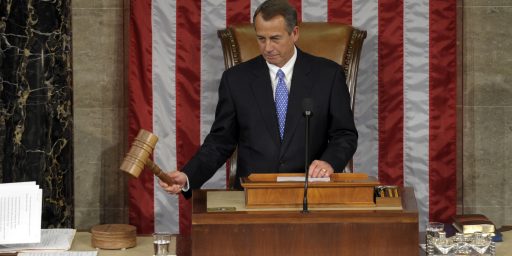Lifting the BP Damage Cap
One of the ways that the DVR has changed my television viewing habits is that, while I stopped watching the Sunday talking heads shows live nearly a decade ago, I now record “This Week” so that I can fast-forward to the roundtable. I virtually always ignore the opening interviews with newsmakers on the theory that 1) they’re unlikely to tell me anything interesting and 2) on the off chance they do, someone else will tell me about it soon enough.
The latter happened today, in the person of Josh Marshall:
House Minority Leader John Boehner on This Week today said he’s now in favor of lifting the cap on BP’s liability in the Gulf oil spill. Though currently law makes BP responsible for cleaning up the actual oil, it limits its liability to $75 million. Senate Democrats have pushed to raise the cap to $10 billion or get rid of the cap entirely. Boehner now seems to be suggesting he’s on board with the latter option but only in the case of BP and this spill, not in general going forward.
Now, I tend to share my colleague Dave Schuler‘s view that the damage cap is a horrible case of corporate welfare and moral hazard rolled into one. It really makes no sense to limit a company’s liability for its own negligence.
But — and this is a big but — it would be unconscionable to change the rules retroactively, much less to do so in what amounts to (as George Will pointed out in the roundtable) a bill of attainder applying to BP only. The bottom line is that the rules were the rules and BP and its competitors made their risk calculations accordingly. Changing them after the fact and throwing a multi-billion dollar penalty flag is not something societies based on the rule of law should do.






In civil matters, we change “the rules” all the time, in terms of procedures, causes of action, avenues for appeal, and limits on the amount and the types of damages.
Put it differently: BP might have known what the risks were, but we certainly didn’t.
Slightly shorter: This is the world’s tiniest violin, playing just for BP.
Amazing how oil companies can have a cap, but medical malpractice lawsuits don’t
In civil matters, we change “the rules” all the time, in terms of procedures, causes of action, avenues for appeal, and limits on the amount and the types of damages.
Sure. Going forward.
James, negligence is irrelevant here. The caps are on damages imposed strictly, regardless of whether BP complied with the standard of care owed. If it’s determined that BP violated any permit, regulation or law or engaged in eggregous conduct that made an accident likely to happen, the caps become inoperative.
“Sure. Going forward.”
No, procedure – and a cap on damages is a procedural rule – can change mid-lawsuit.
I tried to explain the caps in the Dave Schuler thread linked above, but briefly:
1. They only apply to a unique set of damage claims (natural resources damages) and not BP’s responsibility for cleanup or traditional damage claims from people injured or suffering property damage.
2. The natural resources damage claims are a legislative innovation. Courts would not award these without Congressional authorization. When Congress has authorized them in oil and non-oil situations, they’ve capped them.
3. The caps are lifted if BP violated any permit, regulation or law or engaged in egregious conduct that made an accident likely to happen.
The main problem with no cap is that you open a company up to so much potential liability without fault that you risk insolvency in which direct claims (like loss of life or clean-up costs) will be compromised for the benefit of indirect claims.
The main problem with retroactivity is that it scares the hell out of insurance companies, which has made a market in environmental insurance coverage difficult and for some operations non-existent.
Sorry. As mentioned above by PD Shaw, BP loses this protection if, as it appears to be obvious they did, they violated regulations and/or, were egregiously negligent. This cap (which, from PD Shaw’s comment, appears to be more narrowly drawn than I thought it was) should only protect companies that actually play by the rules.
The companies responsible are Transocean and Haliburton, it was Transocean’s rig and people and Haliburton’s technology.
And, I think needs to be pointed out and underscored, the cap you’re talking about applies to actions in federal courts–actions for damages and costs in state and local jurisdictions are not under any cap at all.
Personally, I’m torn about this. Changing the rules in mid-game seems unacceptable. Balanced against this is the fact that the cap was bought and paid for by the oil companies working idiotic (the voters fault) or corrupt (not the voters fault) politicians. So is the relevant analogy one where the designated hitter rule is arbitrarily imposed after the fourth inning because we don’t like who is winning, or one where it is discovered a team managed to sneak a provision into the rulebooks that any team whose name ends in “ees” can add ten games to their win column if they find themselves behind halfway through the season? Upon realization of what the rule means, should it not just be revoked, but retroactively revoked? In this instance, was the cap so flawed, unfair and underhanded that it shouldn’t be just revoked but retroactively revoked?
I may be wrong about this damage cap in other laws. I thought there was one in CERCLA (Superfund), but don’t see it. There is a limit to the amount of financial assurance a company must have.